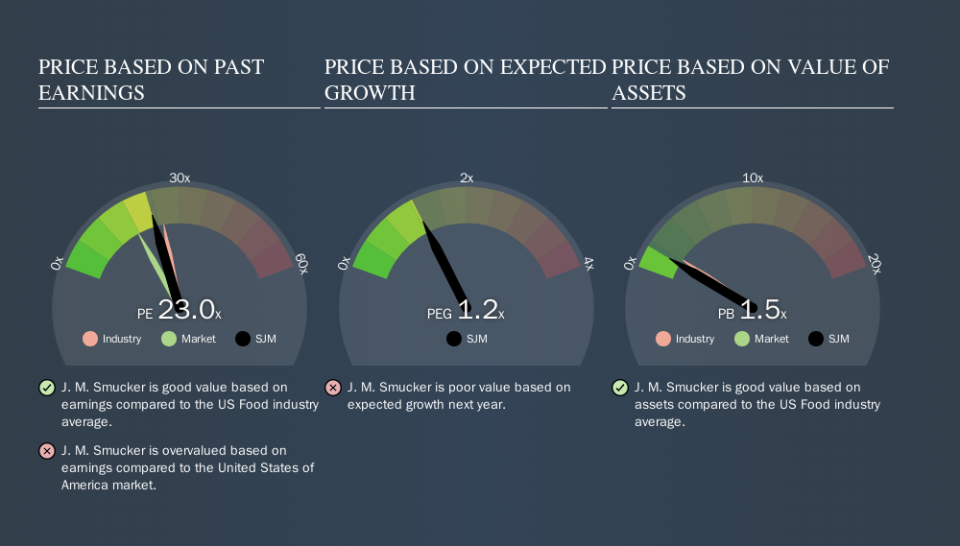Here's What The J. M. Smucker Company's (NYSE:SJM) P/E Ratio Is Telling Us

This article is written for those who want to get better at using price to earnings ratios (P/E ratios). We'll look at The J. M. Smucker Company's (NYSE:SJM) P/E ratio and reflect on what it tells us about the company's share price. Based on the last twelve months, J. M. Smucker's P/E ratio is 22.99. That corresponds to an earnings yield of approximately 4.4%.
See our latest analysis for J. M. Smucker
How Do You Calculate J. M. Smucker's P/E Ratio?
The formula for price to earnings is:
Price to Earnings Ratio = Share Price ÷ Earnings per Share (EPS)
Or for J. M. Smucker:
P/E of 22.99 = $108.27 ÷ $4.71 (Based on the trailing twelve months to July 2019.)
Is A High Price-to-Earnings Ratio Good?
A higher P/E ratio means that buyers have to pay a higher price for each $1 the company has earned over the last year. That isn't a good or a bad thing on its own, but a high P/E means that buyers have a higher opinion of the business's prospects, relative to stocks with a lower P/E.
Does J. M. Smucker Have A Relatively High Or Low P/E For Its Industry?
The P/E ratio indicates whether the market has higher or lower expectations of a company. The image below shows that J. M. Smucker has a lower P/E than the average (25.5) P/E for companies in the food industry.
This suggests that market participants think J. M. Smucker will underperform other companies in its industry. Since the market seems unimpressed with J. M. Smucker, it's quite possible it could surprise on the upside. If you consider the stock interesting, further research is recommended. For example, I often monitor director buying and selling.
How Growth Rates Impact P/E Ratios
Companies that shrink earnings per share quickly will rapidly decrease the 'E' in the equation. Therefore, even if you pay a low multiple of earnings now, that multiple will become higher in the future. A higher P/E should indicate the stock is expensive relative to others -- and that may encourage shareholders to sell.
J. M. Smucker saw earnings per share decrease by 60% last year. And it has shrunk its earnings per share by 2.6% per year over the last five years. This could justify a pessimistic P/E.
A Limitation: P/E Ratios Ignore Debt and Cash In The Bank
It's important to note that the P/E ratio considers the market capitalization, not the enterprise value. Thus, the metric does not reflect cash or debt held by the company. Hypothetically, a company could reduce its future P/E ratio by spending its cash (or taking on debt) to achieve higher earnings.
Such expenditure might be good or bad, in the long term, but the point here is that the balance sheet is not reflected by this ratio.
J. M. Smucker's Balance Sheet
J. M. Smucker's net debt equates to 47% of its market capitalization. While it's worth keeping this in mind, it isn't a worry.
The Bottom Line On J. M. Smucker's P/E Ratio
J. M. Smucker has a P/E of 23.0. That's higher than the average in its market, which is 17.6. With some debt but no EPS growth last year, the market has high expectations of future profits.
Investors have an opportunity when market expectations about a stock are wrong. As value investor Benjamin Graham famously said, 'In the short run, the market is a voting machine but in the long run, it is a weighing machine. So this free visualization of the analyst consensus on future earnings could help you make the right decision about whether to buy, sell, or hold.
Of course you might be able to find a better stock than J. M. Smucker. So you may wish to see this free collection of other companies that have grown earnings strongly.
We aim to bring you long-term focused research analysis driven by fundamental data. Note that our analysis may not factor in the latest price-sensitive company announcements or qualitative material.
If you spot an error that warrants correction, please contact the editor at editorial-team@simplywallst.com. This article by Simply Wall St is general in nature. It does not constitute a recommendation to buy or sell any stock, and does not take account of your objectives, or your financial situation. Simply Wall St has no position in the stocks mentioned. Thank you for reading.

